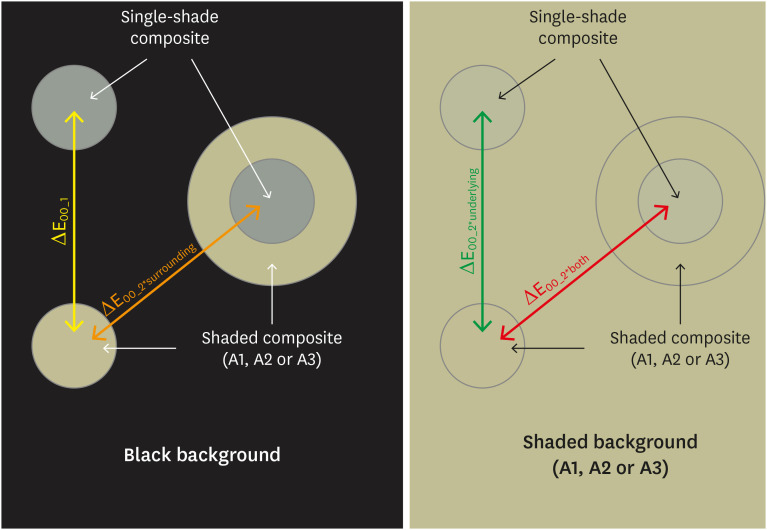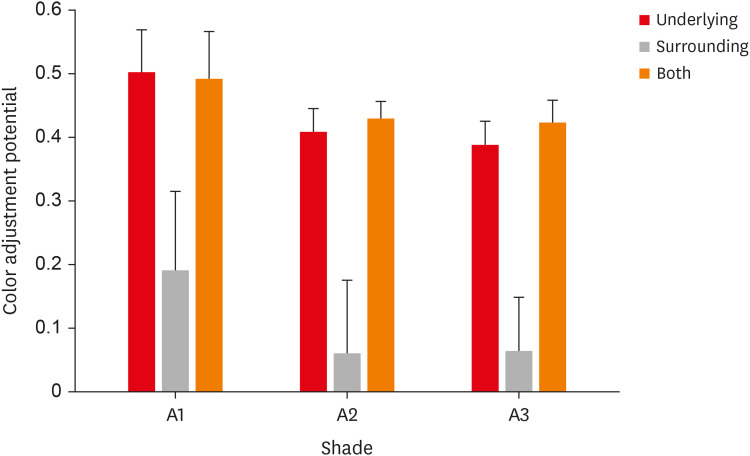Restor Dent Endod.
2023 Feb;48(1):e7. 10.5395/rde.2023.48.e7.
Effects of surrounding and underlying shades on the color adjustment potential of a single-shade composite used in a thin layer
- Affiliations
-
- 1Department of Dentistry, Federal University of Sergipe, Aracaju, SE, Brazil
- KMID: 2548175
- DOI: http://doi.org/10.5395/rde.2023.48.e7
Abstract
Objectives
This study aimed to evaluate the surrounding and underlying shades’ effect on the color adjustment potential (CAP) of a single-shade composite used in a thin layer.
Materials and Methods
Cylinder specimens (1.0 mm thick) were built with the Vittra APS Unique composite, surrounded (dual specimens) or not (simple specimens) by a control composite (shade A1, A2, or A3). Simple specimens were also built only with the control composites. Each specimen’s color was measured against white and black backgrounds or the simple control specimens with a spectrophotometer (CIELAB system). The whiteness index for dentistry (WID ) and translucency parameters (TP 00 ) were calculated for simple specimens. Differences (ΔE00 ) in color between the simple/dual specimens and the controls were calculated. The CAP was calculated based on the ratios between data from simple and dual specimens.
Results
The Vittra APS Unique composite showed higher WID and TP00 values than the controls. The highest values of ΔE00 were observed among simple specimens. The color measurements of Vittra APS Unique (simple or dual) against the control specimens presented the lowest color differences. Only surrounding the single-shade composite with a shaded composite barely impacted the ΔE00 . The highest CAP values were obtained using a shaded composite under simple or dual specimens.
Conclusions
The CAP of Vittra APS Unique was strongly affected by the underlying shade, while surrounding this composite with a shaded one barely affected its color adjustment.
Figure
Reference
-
1. Reis A, Higashi C, Loguercio AD. Re-anatomization of anterior eroded teeth by stratification with direct composite resin. J Esthet Restor Dent. 2009; 21:304–316. PMID: 19796297.
Article2. Pontons-Melo JC, Furuse AY, Mondelli J. A direct composite resin stratification technique for restoration of the smile. Quintessence Int. 2011; 42:205–211. PMID: 21465007.3. Olms C, Klinke T, Pirek P, Hannak WB. Randomized multi-centre study on the effect of training on tooth shade matching. J Dent. 2013; 41:1259–1263. PMID: 24056366.
Article4. Sinmazisik G, Trakyali G, Tarcin B. Evaluating the ability of dental technician students and graduate dentists to match tooth color. J Prosthet Dent. 2014; 112:1559–1566. PMID: 25134993.
Article5. Najafi-Abrandabadi S, Vahidi F, Janal MN. Effects of a shade-matching light and background color on reliability in tooth shade selection. Int J Esthet Dent. 2018; 13:198–206. PMID: 29687098.6. Santos SM, Silva PD, Faria-E-Silva AL. Color changes caused by reduction on the dentin shade composite thickness. Braz Dent J. 2018; 29:469–474. PMID: 30517446.
Article7. Ruiz-López J, Perez MM, Lucena C, Pulgar R, López-Toruño A, Tejada-Casado M, Ghinea R. Visual and instrumental coverage error of two dental shade guides: an in vivo study. Clin Oral Investig. 2022; 26:5961–5968.
Article8. Kobayashi S, Nakajima M, Furusawa K, Tichy A, Hosaka K, Tagami J. Color adjustment potential of single-shade resin composite to various-shade human teeth: Effect of structural color phenomenon. Dent Mater J. 2021; 40:1033–1040. PMID: 33883353.
Article9. de Abreu JL, Sampaio CS, Benalcázar Jalkh EB, Hirata R. Analysis of the color matching of universal resin composites in anterior restorations. J Esthet Restor Dent. 2021; 33:269–276. PMID: 32989879.
Article10. Durand LB, Ruiz-López J, Perez BG, Ionescu AM, Carrillo-Pérez F, Ghinea R, Pérez MM. Color, lightness, chroma, hue, and translucency adjustment potential of resin composites using CIEDE2000 color difference formula. J Esthet Restor Dent. 2021; 33:836–843. PMID: 33283966.
Article11. Ismail EH, Paravina RD. Color adjustment potential of resin composites: Optical illusion or physical reality, a comprehensive overview. J Esthet Restor Dent. 2022; 34:42–54. PMID: 34843636.
Article12. Pereira Sanchez N, Powers JM, Paravina RD. Instrumental and visual evaluation of the color adjustment potential of resin composites. J Esthet Restor Dent. 2019; 31:465–470. PMID: 31095870.
Article13. Lucena C, Ruiz-López J, Pulgar R, Della Bona A, Pérez MM. Optical behavior of one-shaded resin-based composites. Dent Mater. 2021; 37:840–848. PMID: 33658138.
Article14. Brainard DH, Cottaris NP, Radonjić A. The perception of colour and material in naturalistic tasks. Interface Focus. 2018; 8:20180012. PMID: 29951192.
Article15. Arai Y, Kurokawa H, Takamizawa T, Tsujimoto A, Saegusa M, Yokoyama M, Miyazaki M. Evaluation of structural coloration of experimental flowable resin composites. J Esthet Restor Dent. 2021; 33:284–293. PMID: 33098228.
Article16. Saegusa M, Kurokawa H, Takahashi N, Takamizawa T, Ishii R, Shiratsuchi K, Miyazaki M. Evaluation of color-matching ability of a structural colored resin composite. Oper Dent. 2021; 46:306–315. PMID: 34411249.
Article17. Oivanen M, Keulemans F, Garoushi S, Vallittu PK, Lassila L. The effect of refractive index of fillers and polymer matrix on translucency and color matching of dental resin composite. Biomater Investig Dent. 2021; 8:48–53.
Article18. Kobayashi S, Nakajima M, Furusawa K, Tichy A, Hosaka K, Tagami J. Color adjustment potential of single-shade resin composite to various-shade human teeth: Effect of structural color phenomenon. Dent Mater J. 2021; 40:1033–1040. PMID: 33883353.
Article19. Kinoshita S, Yoshioka S, Miyazaki S. Physics of structural colors. Rep Prog Phys. 2008; 71:76401.
Article20. Pérez MM, Ghinea R, Rivas MJ, Yebra A, Ionescu AM, Paravina RD, Herrera LJ. Development of a customized whiteness index for dentistry based on CIELAB color space. Dent Mater. 2016; 32:461–467. PMID: 26778404.
Article21. Johnston WM, Ma T, Kienle BH. Translucency parameter of colorants for maxillofacial prostheses. Int J Prosthodont. 1995; 8:79–86. PMID: 7710631.22. Luo MR, Cui BR, Rigg B. The development of the CIE 2000 colour-difference formula: CIEDE2000. Color Res Appl. 2001; 26:340–350.
Article23. Sharma G, Wu W, Dalal EN. The CIEDE2000 color-difference formula: Implementation notes, supplementary test data, and mathematical observations. Color Res Appl. 2005; 30:21–30.
Article24. Paravina RD, Ghinea R, Herrera LJ, Bona AD, Igiel C, Linninger M, Sakai M, Takahashi H, Tashkandi E, Perez MM. Color difference thresholds in dentistry. J Esthet Restor Dent. 2015; 27(Suppl 1):S1–S9. PMID: 25886208.
Article25. Yamaguchi S, Karaer O, Lee C, Sakai T, Imazato S. Color matching ability of resin composites incorporating supra-nano spherical filler producing structural color. Dent Mater. 2021; 37:e269–e275. PMID: 33563472.
Article26. Shortall AC, Palin WM, Burtscher P. Refractive index mismatch and monomer reactivity influence composite curing depth. J Dent Res. 2008; 87:84–88. PMID: 18096900.
Article27. Faria-E-Silva AL, Pfeifer CS. Impact of thio-urethane additive and filler type on light-transmission and depth of polymerization of dental composites. Dent Mater. 2017; 33:1274–1285. PMID: 28807329.
Article
- Full Text Links
- Actions
-
Cited
- CITED
-
- Close
- Share
- Similar articles
-
- Evaluation of the Color Adjustment Potential of Single-Shade Composite Resin in Primary Teeth
- Depth-Dependent Performance of Single-Shade Composite Resin: Assessing Color Adjustment Potential and Translucency
- Comparison of Optical Properties in Single-Shade and Multi-Shade Composite Resins
- Color Matching of Single-Shade Composite Resin by Various Pulp Capping Materials in Anterior Teeth
- Color discrepancy of single-shade composites at different distances from the interface measured using cell phone images




